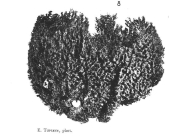WoRMS name details
Spongia linteiformis sensu Lamarck, 1814
193840 (urn:lsid:marinespecies.org:taxname:193840)
unaccepted (genus transfer)
Species
marine, brackish, fresh, terrestrial
recent only
Lamarck, J.-B. de. (1814 [1813]). Sur les polypiers empâtés. <em>Annales du Museum national d'Histoire naturelle.</em> 20: 294-312; 370-386; 432-458.
page(s): 456 [details]
page(s): 456 [details]
Type locality contained in Greater Antilles
, Note According to Topsent (1933) there were three...
type locality contained in Greater Antilles [details]
From editor or global species database
Type material According to Topsent (1933) there were three specimens labeled Spongia linteiformis, one reassigned to to Cacospongia linteiformis by him. with label with origin Porto Rico, a second reassigned to to Echinochalina favosa (Lamarck, 1814 as Spongia) (=E. barba (Lamarck, 1814 as Spongia) from Australia ('Nouvelle-Holande'), and the third reassigned to Ircinia gigantea (Von Lendenfeld, 1889) from unknown locaiity. [details]
Distribution Lamarck (1814) suggested that the specimens were possibly from the Indian Ocean, but Topsent (1933) subsequently discovered...
Homonymy Although Lamarck suggested that his material was similar to Spongia linteiformis Esper, 1794, the two are from widely...
Distribution Lamarck (1814) suggested that the specimens were possibly from the Indian Ocean, but Topsent (1933) subsequently discovered that they were from Puerto Rico. [details]
Homonymy Although Lamarck suggested that his material was similar to Spongia linteiformis Esper, 1794, the two are from widely...
Homonymy Although Lamarck suggested that his material was similar to Spongia linteiformis Esper, 1794, the two are from widely different origins, Esper's material (incertae sedis) is from the Indo-Pacific, Lamarck's from Puerto Rico (and additional specimens, not assigned to Cacospongia by Topsent (1933) are assigned to Echinochalina and Ircinia. The Caribbean species needs to be renamed as it is a junior primary homonym. [details]
de Voogd, N.J.; Alvarez, B.; Boury-Esnault, N.; Cárdenas, P.; Díaz, M.-C.; Dohrmann, M.; Downey, R.; Goodwin, C.; Hajdu, E.; Hooper, J.N.A.; Kelly, M.; Klautau, M.; Lim, S.C.; Manconi, R.; Morrow, C.; Pinheiro, U.; Pisera, A.B.; Ríos, P.; Rützler, K.; Schönberg, C.; Turner, T.; Vacelet, J.; van Soest, R.W.M.; Xavier, J. (2025). World Porifera Database. Spongia linteiformis sensu Lamarck, 1814. Accessed through: World Register of Marine Species at: https://www.marinespecies.org/aphia.php?p=taxdetails&id=193840 on 2025-05-03
Date
action
by
![]() The webpage text is licensed under a Creative Commons
Attribution 4.0 License
The webpage text is licensed under a Creative Commons
Attribution 4.0 License
Nomenclature
original description
Lamarck, J.-B. de. (1814 [1813]). Sur les polypiers empâtés. <em>Annales du Museum national d'Histoire naturelle.</em> 20: 294-312; 370-386; 432-458.
page(s): 456 [details]
basis of record Topsent, E. (1933). Eponges de Lamarck conservées au Muséum de Paris. Fin. <em>Archives du Muséum national d'histoire naturelle, Paris.</em> 10: 1-60.
page(s): 8-9 [details] Available for editors [request]
[request]
new combination reference Van Soest, R.W.M. (2024). Correcting sponge names: nomenclatural update of lower taxa level Porifera. <em>Zootaxa.</em> 5398(1): 1-122., available online at https://doi.org/10.11646/zootaxa.5398.1.1
page(s): 26 [details] Available for editors [request]
[request]
page(s): 456 [details]
basis of record Topsent, E. (1933). Eponges de Lamarck conservées au Muséum de Paris. Fin. <em>Archives du Muséum national d'histoire naturelle, Paris.</em> 10: 1-60.
page(s): 8-9 [details] Available for editors
new combination reference Van Soest, R.W.M. (2024). Correcting sponge names: nomenclatural update of lower taxa level Porifera. <em>Zootaxa.</em> 5398(1): 1-122., available online at https://doi.org/10.11646/zootaxa.5398.1.1
page(s): 26 [details] Available for editors
 Present
Present  Present in aphia/obis/gbif/idigbio
Present in aphia/obis/gbif/idigbio  Inaccurate
Inaccurate  Introduced: alien
Introduced: alien  Containing type locality
Containing type locality
From editor or global species database
Classification Lamarck’s species name is a junior primary homonym of Spongia linteiformis Esper (1797: 205, pl. LVIII), although Lamarck did mention Esper’s name with a question mark. Topsent’s (1933: 8, pl. I fig. 8) redescription and illustration of the type specimen in MNHN, registration not currently known (reproducedhere) make it amply clear that the two are different species, and also their localities are from different oceans (Lamarck’s specimen was from Puerto Rico, Esper’s from the Indian Ocean). Although the identity of Esper’s sponge is uncertain (it is not even certain that it concerns a sponge), Lamarck’s name must be replaced (ICZN art. 59.1) here replaced by Scalarispongia lamarcki nom.nov., because from Topsent’s redescription it can be deduced that it is a member of genus Scalarispongia Cook & Bergquist, 2000. Fattorusso et al. (1992) reported biochemical information (unprecedented sesterterpenes) from a specimen from the Bahamas of this species identified with some uncertainty. According to Topsent (1933: 9), Lamarck’s collection contained two additional specimens labeled
Distribution Lamarck (1814) suggested that the specimens were possibly from the Indian Ocean, but Topsent (1933) subsequently discovered that they were from Puerto Rico. [details]
Homonymy Although Lamarck suggested that his material was similar to Spongia linteiformis Esper, 1794, the two are from widely different origins, Esper's material (incertae sedis) is from the Indo-Pacific, Lamarck's from Puerto Rico (and additional specimens, not assigned to Cacospongia by Topsent (1933) are assigned to Echinochalina and Ircinia. The Caribbean species needs to be renamed as it is a junior primary homonym. [details]
Identification The species is not recently recognized in the Caribbean sponge fauna and should be considered incertae sedis. [details]
Type material According to Topsent (1933) there were three specimens labeled Spongia linteiformis, one reassigned to to Cacospongia linteiformis by him. with label with origin Porto Rico, a second reassigned to to Echinochalina favosa (Lamarck, 1814 as Spongia) (=E. barba (Lamarck, 1814 as Spongia) from Australia ('Nouvelle-Holande'), and the third reassigned to Ircinia gigantea (Von Lendenfeld, 1889) from unknown locaiity. [details]
